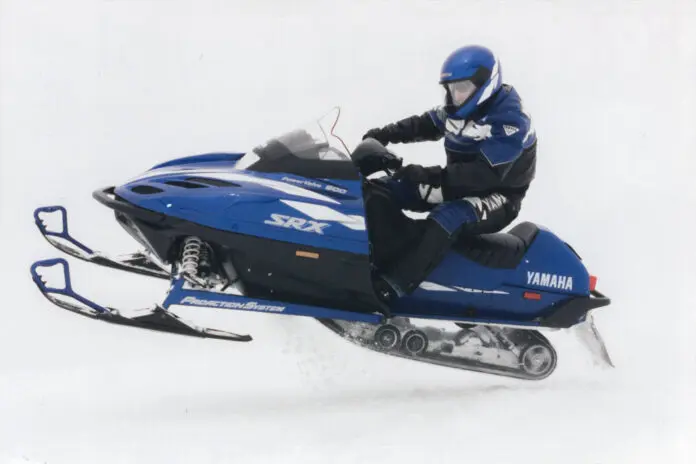After the arrival and relatively quick retirement of the four cylinder Vmax-4 in the early 1990’s Yamaha doubled down on its next attempt at a true lake-honing, unapologetic Hyper Sled. This time the company was dealing with a new, in-house chassis featuring a trailing arm IFS and a double coupled skidframe. This new “Pro Action” chassis was a great platform on which to launch an all-out, no-holds-barred rocket ship.
Preceding (and living after) the 98/99 SRX 600 – was the SRX 700. The 600 SRX was only a set of de-bored cylinders away from its sibling, the 700 SRX. The basic SRX engine package was the same as the reed valve inducted powerplant used in the Vmax 700 SX triple. The 600 SRX got triple pipes, power valves and a trio of 33mm Mikuni TM series, rack mounted flat slide carbs. The net result is widely accepted as 120 to 125 HP and an indicated 100-plus MPH top end down Kevlar Lake.
SRX always meant lake shredding velocity. However, it had been almost 20 years since Yamaha had hung the moniker on a snowmobile. For the faithful, the stakes were high. Particularly confounding was the absolute dominance (at that time) of the SRX 700. This sled landed with a thunderous impact on the radar run, lake racing snowmobile cognoscenti. The SRX 600? Not so much.
First year SRX 600’s came with a flawed crankshaft – not a small issue – and as a result all 98 SRX 600’s received a new crank early that season. Surprisingly, sales of the 600 SRX did not impress the braintrust at Yamaha and as a result the sled was only offered for two model years, 1998 and 99.
Even though for a 600 class sled the SRX was legitimately potent, the target audience for a no-holds-barred lake weapon is the guy who goes to the top drawer – not one shelf down. Essentially, if you’re going to show up Saturday morning on Kevlar Lake, you come with the biggest gun in the closet or stay home.
Here’s another baffling reality of the 600 SRX. Even though it came with Yamaha’s new trailing arm, equal length radius rod IFS and a full-on double coupled skid, Yamaha elected to shorten up the suspension’s available travel in an effort to improve max lake velocity by lowering the chassis and flattening the arc of the track as it travels around the rear suspension skid. Both are great moves for improving top end, however, the improvement comes at a pretty substantial cost. Namely, ride compliance. Both SRX models were not known for trail riding comfort.
There was an upside to the SRX 600’s lowering and that was exceptional handling on smooth, twisty trails. Suffice it to say lowering the center of gravity on the SRX 600 made for heroic runs through the corners.
The SRX 600 story lives on today with this sled being among a handful of exceptionally desirable snowmobiles. No hardcore Yama-Guru would consider his or her collection of vintage sleds complete without a copy of the very limited production and, as a result, very rare, 98 and/or 99 SRX 600.








